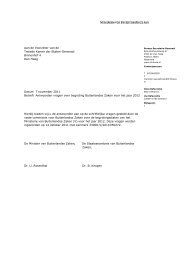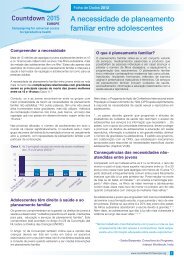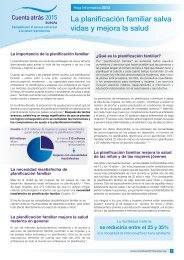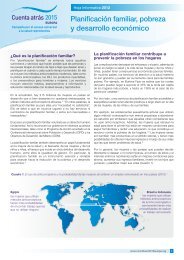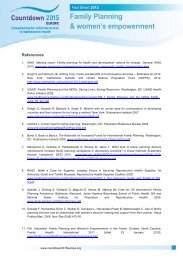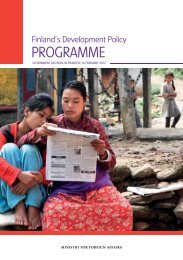The Unmet Need for Family Planning - Countdown 2015 Europe
The Unmet Need for Family Planning - Countdown 2015 Europe
The Unmet Need for Family Planning - Countdown 2015 Europe
You also want an ePaper? Increase the reach of your titles
YUMPU automatically turns print PDFs into web optimized ePapers that Google loves.
1.3 Consequences of unmet needNot meeting the need <strong>for</strong> family planning in developing countrieshas widespread impact, affecting families, communities andeconomies, not to mention individual health and well-being.For example, unmet need:••increases maternal and child morbidity and mortality,particularly when births cannot be adequately spaced(Ash<strong>for</strong>d 2003; Mackenzie, Drahota et al. 2010);••leads to an increase in unsafe abortions (Ash<strong>for</strong>d 2003;Mackenzie, Drahota et al. 2010);••contributes to the incidence of HIV and sexually transmittedinfections (STIs) (WHO 2010);••compromises women’s abilities to be productive in theircommunities and national economies (Mackenzie, Drahotaet al. 2010);••<strong>for</strong>ces girls and young women to drop out of school due tounplanned pregnancies (Barot 2008);••exacerbates women’s lower social status and genderinequality (FHI);••increases poverty and slows economic growth (RHSC 2009;Speidel, Sinding et al. 2009); and••contributes to unsustainable population growth (Ash<strong>for</strong>d 2003).Quick Facts: some consequences of unmet needEconomicMaternal and newborn deaths slow growth and lead to globalproductivity losses of US$15 billion each year (UK All Party ParliamentaryGroup on Population, Development and Reproductive Health 2009;Vlassoff, Sundaram et al. 2009; UN Secretary General 2010).EducationalApproximately 8–25% of young women in some sub-Saharan Africancountries drop out of school because of unintended pregnancy.Among unmarried 15–17-year-olds, those in school were morelikely to use contraceptives than those out of school (Barot 2008;Guttmacher/IPPF 2010).HealthTermination of unintended pregnancies in unsafe conditions is thethird main cause of maternal death worldwide (WHO 2011). Whilerisks associated with childbirth cannot be completely eliminated,only deaths due to unsafe abortion are entirely preventable (Speidel,Sinding et al. 2009; WHO 2011).1.4 Progress and set-backs in addressing unmet needOver the past two decades, the use of contraceptives increasedamong women in almost every region. By 2007, approximately60% of married women of reproductive age were using some<strong>for</strong>m of contraception (UN-DESA 2011). It is important to note,however, that data about contraceptive use among unmarriedwomen (Sedgh, Hussain et al. 2007) and adolescent girls indeveloping countries are limited compared to data on marriedwomen, particularly in Asia, so global levels of unmet need maybe higher than statistics suggest.However, there has been a considerable slowdown in meetingthe unmet need in the past decade and a widening gap amongregions. According to the United Nations, the annual rate ofincrease in contraceptive prevalence in almost all regions waslower from 2000 to 2007 than it was during the 1990s. Andcontraceptive prevalence in some regions, such as sub-SaharanAfrica, continues to be low (UN-DESA 2011; UN 2011). In somecountries, such as Ghana and Benin, there have even beenreversals in contraceptive prevalence (UN 2011).<strong>The</strong> increase in unmet need <strong>for</strong> family planning is linked toreductions in political commitment and funding. For example,restrictions on funding <strong>for</strong> reproductive health by the USgovernment during the presidency of George W. Bush (i.e., theMexico City Policy or ‘Global Gag Rule’) led to cuts in familyplanning services in many countries, which is likely to havecontributed to increasing unmet need (Lancet/UCL 2009). Inaddition, while there have been large increases in funding to‘population’ budget lines, much of this has gone towards HIV/AIDS (Lancet/UCL 2009) rather than family planning. <strong>The</strong> lack oftransparency in budget lines and the lack of a dedicated budgetline specifically <strong>for</strong> family planning have led to a false confidencethat family planning has received adequate funds, when in fact ithas not, and the result is an increase in unmet need.1.5 Future projections of unmet needAccording to projections by the United Nations, the number ofwomen of reproductive age (15–49) will grow by almost 33% inthe next decade (Ross and Stover 2009). Between 2008 and<strong>2015</strong>, demand <strong>for</strong> family planning in the developing world willlikely increase from the current 867 million to 933 million women,and the number of family planning users will increase from 645million to 709 million users, a projected increase of 106 millionusers. This is equivalent to almost half the current level of unmetneed. <strong>The</strong> projected increase in demand between now and <strong>2015</strong>would leave around 224 million women with an unmet need <strong>for</strong>modern contraception, compared to today’s 222 million (RHSC).<strong>The</strong> impact of failing to meet the contraceptive needs and desiresof 222 million women is devastating <strong>for</strong> women, young people,families and societies, and the situation will only intensify as thelargest cohort of young people ever becomes sexually active: 1.5billion adolescents are now entering their sexual and reproductiveyears (IPPF 2008; UN 2009).www.countdown<strong>2015</strong>europe.org9




